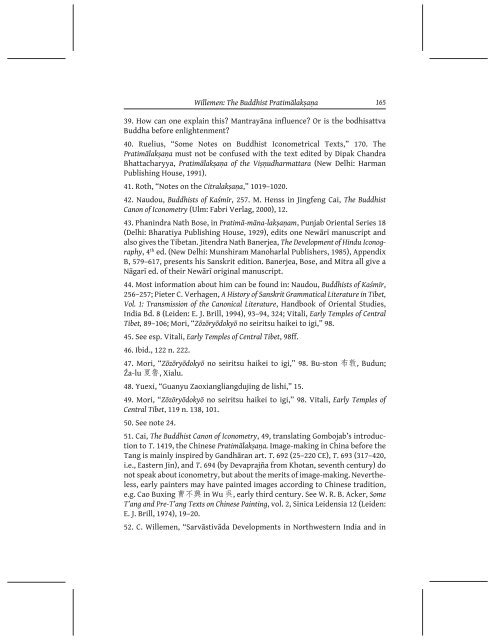download - The Institute of Buddhist Studies
download - The Institute of Buddhist Studies
download - The Institute of Buddhist Studies
Create successful ePaper yourself
Turn your PDF publications into a flip-book with our unique Google optimized e-Paper software.
Willemen: <strong>The</strong> <strong>Buddhist</strong> Pratimālakṣaṇa 165<br />
39. How can one explain this? Mantrayāna influence? Or is the bodhisattva<br />
Buddha before enlightenment?<br />
40. Ruelius, “Some Notes on <strong>Buddhist</strong> Iconometrical Texts,” 170. <strong>The</strong><br />
Pratimālakṣaṇa must not be confused with the text edited by Dipak Chandra<br />
Bhattacharyya, Pratimālakṣaṇa <strong>of</strong> the Viṣṇudharmattara (New Delhi: Harman<br />
Publishing House, 1991).<br />
41. Roth, “Notes on the Citralakṣaṇa,” 1019–1020.<br />
42. Naudou, <strong>Buddhist</strong>s <strong>of</strong> Kaśmīr, 257. M. Henss in Jingfeng Cai, <strong>The</strong> <strong>Buddhist</strong><br />
Canon <strong>of</strong> Iconometry (Ulm: Fabri Verlag, 2000), 12.<br />
43. Phanindra Nath Bose, in Pratimā-māna-lakṣaṇam, Punjab Oriental Series 18<br />
(Delhi: Bharatiya Publishing House, 1929), edits one Newārī manuscript and<br />
also gives the Tibetan. Jitendra Nath Banerjea, <strong>The</strong> Development <strong>of</strong> Hindu Iconography,<br />
4 th ed. (New Delhi: Munshiram Manoharlal Publishers, 1985), Appendix<br />
B, 579–617, presents his Sanskrit edition. Banerjea, Bose, and Mitra all give a<br />
Nāgarī ed. <strong>of</strong> their Newārī original manuscript.<br />
44. Most information about him can be found in: Naudou, <strong>Buddhist</strong>s <strong>of</strong> Kaśmīr,<br />
256–257; Pieter C. Verhagen, A History <strong>of</strong> Sanskrit Grammatical Literature in Tibet,<br />
Vol. 1: Transmission <strong>of</strong> the Canonical Literature, Handbook <strong>of</strong> Oriental <strong>Studies</strong>,<br />
India Bd. 8 (Leiden: E. J. Brill, 1994), 93–94, 324; Vitali, Early Temples <strong>of</strong> Central<br />
Tibet, 89–106; Mori, “Zōzōryōdokyō no seiritsu haikei to igi,” 98.<br />
45. See esp. Vitali, Early Temples <strong>of</strong> Central Tibet, 98ff.<br />
46. Ibid., 122 n. 222.<br />
47. Mori, “Zōzōryōdokyō no seiritsu haikei to igi,” 98. Bu-ston 布 敦 , Budun;<br />
Źa-lu 夏 魯 , Xialu.<br />
48. Yuexi, “Guanyu Zaoxiangliangdujing de lishi,” 15.<br />
49. Mori, “Zōzōryōdokyō no seiritsu haikei to igi,” 98. Vitali, Early Temples <strong>of</strong><br />
Central Tibet, 119 n. 138, 101.<br />
50. See note 24.<br />
51. Cai, <strong>The</strong> <strong>Buddhist</strong> Canon <strong>of</strong> Iconometry, 49, translating Gombojab’s introduction<br />
to T. 1419, the Chinese Pratimālakṣaṇa. Image-making in China before the<br />
Tang is mainly inspired by Gandhāran art. T. 692 (25–220 CE), T. 693 (317–420,<br />
i.e., Eastern Jin), and T. 694 (by Devaprajña from Khotan, seventh century) do<br />
not speak about iconometry, but about the merits <strong>of</strong> image-making. Nevertheless,<br />
early painters may have painted images according to Chinese tradition,<br />
e.g. Cao Buxing 曹 不 興 in Wu 呉 , early third century. See W. R. B. Acker, Some<br />
T’ang and Pre-T’ang Texts on Chinese Painting, vol. 2, Sinica Leidensia 12 (Leiden:<br />
E. J. Brill, 1974), 19–20.<br />
52. C. Willemen, “Sarvāstivāda Developments in Northwestern India and in
















